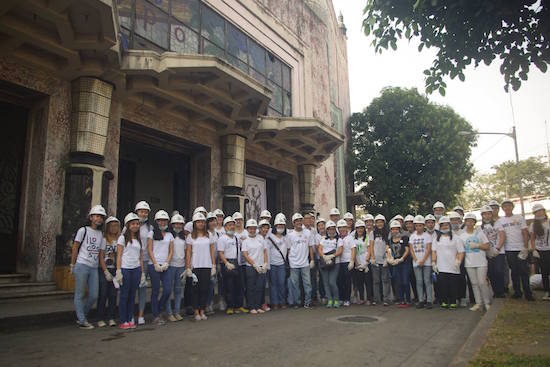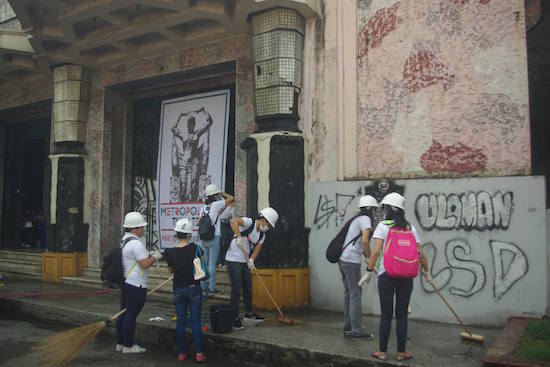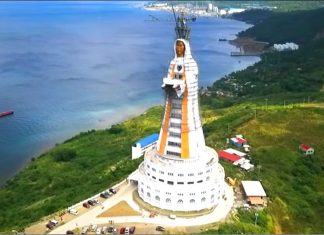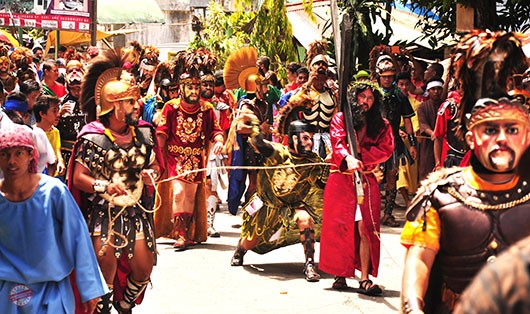The iconic arts building of the Manila Metropolitan Theater is set to be restored to its former glory by the METamorphosis team of the National Commission for Culture and the Arts (NCCA) and students from various universities.

The historical building’s restoration project began in December last year with a clean up drive after the NCCA was granted ownership rights for the MET.
A second clean up drive on the art deco building was done this January. Weekly clean up drives are being held in January and February, according to the organizers.
Participating in the drive are students from UP Diliman, University of Sto.Tomas, De La Salle- College of St. Benilde, MAPUA, University of the East-Caloocan, National University, Technological University of the Philippines, Far Eastern University, Technological Institute of the Philippines, Bulacan State University, Polytechnic University of the Philippines, EARIST, Letran and Centro Escolar University.
Restoration team head Gerard Lico told media, “We want the students to be more involved in the restoration because it will help them connect with their historical and cultural heritage. They will also have a sense of ownership.”
Lico also pointed out that the volunteer-based activity will help architecture students who are planning to do an in-depth study or to write a thesis about the MET as a historical architectural treasure.
In their Facebook page post the project team also invited De La Salle University-Dasmarinas alumnus Bilog Bilugan and his Philippine History in Color project on the MET to be part of the efforts after seeing his work featured on GoodNewsPilipinas.com.
The art deco architecture of the MET was designed by National Artist for Architecture Juan Arellano in 1931. The NCCA declared the building a National Cultural Treasure for its social and political value.
Lico adds, “The theater is not just an important landmark, it is a symbol of Manila. It was the premier cultural venue during the pre-war period. It is a survivor of World War II. While the buildings and other infrastructure around it have been torn down or were bombed during the war, it remained intact except for the damage on its roof.”
The project team recalls the glory of the the MET in its Facebook page. The theater’s artworks are by renowned artists. Two murals, “The Dance,” and “The History of Music,” at the balcony of the MET were painted by National Artist for Visual Arts Fernando Amorsolo. Plant-themed carvings in the interiors were by Filipino artist Isabelo Tampingco. The Adam and Eve sculptures found at the main lobby are by artist Francesco Riccardo Monti.
Arellano had also worked on the nearby Legislative Building and the Post Office Building in the neoclassic style. He however elected to have the Metropolitan Theater done in the art deco style, festive and colorful.
The site was an 8,393.58-sqm lot in the Mehan Gardens, between Burgos Avenue and Arroceros St, which had been leased by the City of Manila to the Metropolitan Theater Company. The P1,000,000 needed for the project was raised by public subscription. Arellano was sent to the United States to study with Thomas W. Lamb, an American expert in theater design.
The theater proper was flanked by garden courts around which were two-story buildings housing the ballroom, restaurant, offices, and shops. The front of the theater was crowned by a wall gently curved at the top, against which rise a series of pinnacles. The entrance resembled a proscenium, On the lower half were doors with iron grills depicting stylized birds of paradise, and on the upper half was a large window of colored glass. This exterior proscenium was set against undulating walls decorated with brillantly colored batik patterns.
The two-story lobby, with wide stairways at each end and a balcony overlooking the entrance, was the elegant setting for Fernando Amorsolo’s murals The Dance and History of Music, and the Italian sculptor Francesco Monti’s modern statues.
The original capacity of the auditorium was 1,670 : 846 in the orchestra, 708 in the balcony, and 116 in the loge. Enshrined above the proscenium were figures depicting Music, Tragedy,
Comedy, and Poetry, set amid an array of jewel-like plaques. Adorning the plain walls were lamps, tall tapering tubes of translucent glass in the form of bamboo stalks. On the ceiling was a luxuriant array of rropical fruits and foliage. Hartendorp described the acoustics as”faultless”and the lighting as”excellent.”
The auditorium was destroyed in the last days of WWII, and its subsidiary buildings were used by various establishments. The building was restored under the supervision of Otilio Arellano, a nephew of Juan Arellano, and was reinaugurated on 10 December 1978.
Years have not been kind to the MET however and it has since fallen to disrepair.
METamorphosis seeks to reverse this state.












